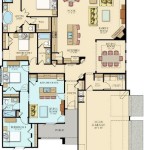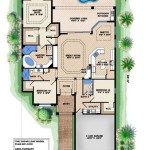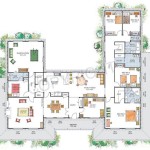How To Get Floor Plans For Your House
Floor plans are essential blueprints that depict the layout of a building from a bird's-eye view. They illustrate the relationships between rooms, spaces, physical features, and other important architectural elements. Obtaining a floor plan for a house is a crucial step in numerous projects, whether for renovations, interior design, real estate transactions, or simply for archival records. This article outlines various methods for acquiring floor plans for a house, addressing different scenarios and resources available.
Searching Existing Records and Documentation
The first and often most straightforward approach to obtaining a floor plan is to search existing records and documentation associated with the property. These records may be held by the homeowner, previous owners, or various governmental and private organizations.
One of the primary places to look is within the homeowner’s personal records. When a house is initially constructed or undergoes significant renovations requiring permits, floor plans are typically generated. These plans are often kept by the homeowner alongside other important property documents, such as deeds, mortgages, and property tax records. Reviewing these files carefully may reveal the desired floor plan.
If the current homeowner does not possess the floor plan, contacting previous owners can be a worthwhile endeavor. Past residents might have retained copies of the plans or can provide information regarding the origin of the plans. Real estate agents who facilitated previous sales of the property may also possess records of floor plans, especially if they were used in marketing materials.
Local government offices, particularly those responsible for building permits and zoning regulations, represent a potentially valuable resource. Building departments and planning departments frequently maintain archives of construction documents, including floor plans, for properties within their jurisdiction. These records are typically public and accessible, although accessing them might involve a fee or a specific procedural requirement. Individuals should contact the relevant local office and inquire about their record-keeping practices and procedures for accessing architectural documents.
County recorder offices or land registry offices can also be consulted. These offices are responsible for maintaining records of property ownership and transactions. While they may not always possess detailed floor plans, they might hold surveys or other documents that provide information about the property's dimensions, boundaries, and overall layout. This information can be used as a basis for creating a floor plan if one does not already exist.
In some instances, particularly for newer developments or properties within planned communities, the homeowner's association (HOA) or property management company might maintain architectural plans. These organizations often have access to original construction documents for all properties within the community and may be willing to provide copies to homeowners.
Finally, if the house was built by a specific builder or developer, contacting that entity directly can be productive. The builder likely retains copies of the original plans and can provide them to the current homeowner, often for a fee. This is particularly helpful if the house is part of a larger development constructed by a known company.
Hiring Professionals to Create New Floor Plans
If existing floor plans cannot be located, the alternative is to engage professionals to create new ones. This option is more costly than locating existing plans, but it ensures accuracy and provides an updated representation of the house's current configuration.
Architects are highly qualified professionals who can create detailed and accurate floor plans. They possess the training and expertise to measure the house precisely, understand building codes and regulations, and produce professional-quality drawings. Hiring an architect is particularly advisable for complex projects, such as major renovations or additions, where precise measurements and code compliance are critical.
Interior designers also can create floor plans, although their focus is often on the interior layout and design elements. While they may not possess the same level of technical expertise as architects regarding structural elements, they are skilled at visualizing space and creating functional and aesthetically pleasing layouts. Interior designers are a good option for projects primarily focused on interior remodeling or space planning.
Draftspersons are professionals specializing in creating technical drawings. They can translate rough sketches, measurements, or verbal descriptions into detailed floor plans. Draftspersons typically charge less than architects or interior designers, making them a more budget-friendly option for creating accurate floor plans. It is imperative to verify the draftsperson's experience and qualifications to ensure the quality and accuracy of the work.
Land surveyors can provide valuable information about the property's boundaries, dimensions, and topography. While they do not typically create detailed interior floor plans, they can generate site plans that show the location of the house on the property and its relationship to surrounding features. This information can be used in conjunction with interior measurements to create a comprehensive floor plan.
When hiring a professional to create a floor plan, it is crucial to clearly define the scope of work and the deliverables. Specify the level of detail required, the format of the final plans (e.g., paper copies, digital files), and the intended use of the plans. Obtain multiple quotes from different professionals to ensure competitive pricing and compare their experience and qualifications. A written contract should be in place outlining the terms of the agreement, including payment schedule and ownership of the plans.
The process of creating a floor plan typically involves several steps. The professional will first visit the house to take detailed measurements of all rooms, hallways, and other spaces. They will use specialized tools, such as laser measuring devices, to ensure accuracy. These measurements are then used to create a digital drawing of the floor plan, which can be further refined and annotated to show the locations of doors, windows, fixtures, and other important features. The final floor plan can be provided in various formats, including PDF, DWG (AutoCAD), or other industry-standard formats.
Utilizing Technology and DIY Methods
For individuals seeking a more cost-effective or hands-on approach, various technology-based and DIY methods exist for creating floor plans.
Numerous software applications and online tools are available for creating floor plans. These tools range from simple, user-friendly programs suitable for basic layouts to more advanced software with features for 3D modeling and rendering. Some popular options include SketchUp, AutoCAD, RoomSketcher, and Floorplanner. These tools often offer free trial periods or limited free versions, allowing users to experiment and determine if the software meets their needs.
The process of using floor plan software typically involves creating a digital representation of the house's outline, adding walls, doors, and windows, and then populating the space with furniture and fixtures. Most software programs offer libraries of pre-designed elements that can be easily inserted into the plan. While using these tools requires some initial learning, many offer tutorials and online support to guide users through the process.
Mobile apps designed for creating floor plans are another convenient option. These apps typically use the device's camera and sensors to measure rooms and create 3D models. Some apps utilize augmented reality (AR) technology to overlay the floor plan onto a live view of the space. Popular floor plan apps include Magicplan, RoomScan Pro, and Polycam. These apps are particularly useful for creating quick and basic floor plans, although their accuracy may vary depending on the quality of the device and the lighting conditions.
Creating a floor plan manually involves measuring each room and space in the house using a measuring tape and then drawing the layout on graph paper or using a CAD program. This method requires patience and attention to detail but can be a cost-effective option for simple floor plans. It is important to take accurate measurements and to maintain consistent scale throughout the drawing.
Regardless of the method used, it is crucial to verify the accuracy of the floor plan. Double-check all measurements and compare them to existing records, such as property surveys or tax assessor maps. It is also advisable to have a professional review the floor plan, especially if it will be used for important projects, such as renovations or real estate transactions.
When using technology to create floor plans, be mindful of the software's limitations and potential inaccuracies. Mobile apps, in particular, may be affected by factors such as lighting conditions and the device's sensor capabilities. It is always recommended to supplement technology-based methods with manual measurements and verification to ensure the accuracy of the final floor plan.
Obtaining a floor plan for a house can be achieved through various means, each with its own advantages and disadvantages. The appropriate method depends on factors such as the availability of existing records, budget constraints, and the intended use of the floor plan. By thoroughly exploring available resources and considering the options outlined in this article, individuals can successfully acquire the necessary floor plans for their projects.

House Plans How To Design Your Home Plan

9 Ways To Find Floor Plans Of An Existing House Blueprints Archid

House Plans How To Design Your Home Plan

Floor Plan Creator And Designer Free Easy App

House Plans How To Design Your Home Plan

House Plans How To Design Your Home Plan

Where You Can Buy House Plans Live Home 3d

House Plans How To Design Your Home Plan

Make Your Own Blueprint How To Draw Floor Plans

House Plans How To Design Your Home Plan
Related Posts








